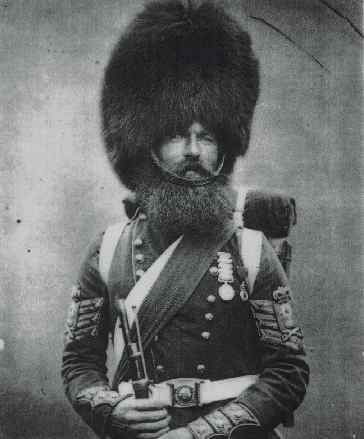
Above - A colour sergeant of the 72nd Highlanders in 1856.
The rank of colour sergeant was introduced into the British Army in 1813. The post was a position of honour for outstanding sergeants, providing recognition and extra pay. Historically, Colour Sergeants of British line regiments were tasked with protecting Ensigns, the most junior officers who were responsible for carrying their battalions' Colours (flag or insignia) to rally troops in battles. For this reason the Colour Sergeant rank was considered a prestigious one given normally to courageous Sergeants who had attained accomplishments in battles.
The practice of carrying Colours of uniform design to identify each regiment and provide a rally point in the confusion of battle commenced in 1639. The Colours were carried in battle in the centre of the front rank between the centre companies where they could be easily seen and recognised. This had a moral raising effect on the spirits of the troops. It also meant that the once battle was joined the Colour Party became an obvious target and the centre would see the most bitter fighting.
By the mid-19th century, the title Colour Sergeant was equivalent to Staff Sergeant, and the use of one or the other title would vary from one branch of the armed forces to the other. The rank of Colour Sergeant was used in infantry regiments, but the function of the position had advanced beyond protecting the regiment's colours. Colour Sergeants had duties that encompassed the regiment as a whole, not a particular platoon of men as would be case with a regular Sergeant. In fact, staff sergeants might actually have several sergeants working underneath them. The origin of the concept of Staff Sergeants is that they were part of the staff of a British army regiment and were paid at that level rather than as a member of a battalion or company.
In the British Army Infantry, a Sergeant is in charge of the administration of a platoon of soldiers (usually around 30 men) and is charged with leading them into battle. A Colour Sergeant is in charge of distributing kit and equipment and making sure the company's living quarters are fine. During battle operations, he makes sure the company has enough food, water and ammunition. (A company is usually around 120 men). To give you a sense of the regiment's non-commissioned officer hierarchy, I found information on the composition of the 72nd regiment during the India campaign through a website that listed all the members of the army who received medals for their service (i.e., the entire regiment). The 72nd had 1 Sergeant-Major, 6 Colour Sergeants, 27 sergeants, 50 corporals, and 536 privates.
Sources
Various web sites, including
Dix Noonan Webb Indian Mutiny Medal Roll: http://www.dnw.co.uk/medals/resources/medalrolls/indianmutiny/
British Army Other Ranks: http://en.wikipedia.org/wiki/British_Army_Other_Ranks_rank_insignia
What is the difference between a sergeant, a staff sergeant, & a colour sergeant? http://uk.answers.yahoo.com/question/index?qid=20080828074841AAi8tnE